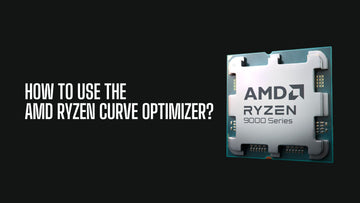
If you’re looking to squeeze every bit of performance from your AMD Ryzen processor, then you’ve likely heard about the AMD Ryzen Curve Optimizer.
But what exactly is it, and how can you use it to optimize your CPU for better performance and efficiency?
Let’s dive deep into this powerful tool and uncover how you can use it to elevate your system’s capabilities.
How to Fix SteamVR Error Code 109?
What is the AMD Ryzen Curve Optimizer?

The AMD Ryzen Curve Optimizer is a feature integrated within the AMD Ryzen Master software and accessible via BIOS settings on supported motherboards.
It allows you to fine-tune the voltage-frequency curve of your Ryzen CPU, offering a level of customization that goes beyond traditional overclocking methods.
In simple terms, the Curve Optimizer helps you adjust how much voltage your CPU receives at different performance levels.
By carefully tweaking these settings, you can improve your processor's efficiency, reduce heat output, and potentially unlock higher performance without pushing your hardware to its limits.
How Does the Curve Optimizer Work?

At its core, the Curve Optimizer operates on the principle of undervolting. This means reducing the voltage supplied to your CPU, especially during high-performance tasks.
Lower voltage translates to lower power consumption and reduced heat generation, allowing your CPU to maintain higher boost frequencies for longer periods without overheating.
-
Per-Core vs. All-Core Adjustments: One of the standout features of the Curve Optimizer is the ability to tweak settings per core or for all cores at once. This is especially useful because not all CPU cores are created equal—some might handle lower voltages better than others.
-
Dynamic Adjustments: Unlike static overclocking, the Curve Optimizer allows dynamic adjustments based on workload. This ensures that your CPU performs optimally whether you’re gaming, editing videos, or just browsing the web.
Why Should You Use the Curve Optimizer?

So, what’s the big deal? Here’s why you might want to consider using the Curve Optimizer:
-
Boosted Performance: By finding the perfect voltage-frequency balance, you can achieve higher clock speeds without risking stability.
-
Lower Temperatures: Less voltage means less heat. This can extend the life of your CPU and reduce the need for aggressive cooling solutions.
-
Increased Power Efficiency: If you’re mindful of your system’s power consumption—especially in a laptop or small form factor PC—the Curve Optimizer can help you strike the perfect balance.
-
Customizable Experience: Whether you're a hardcore gamer, a content creator, or just someone who loves to tinker, the Curve Optimizer lets you tailor your system’s performance to your specific needs.
Before You Start

Before diving into the Curve Optimizer, make sure you have the following:
-
AMD Ryzen Master: Download and install the latest version from AMD’s official website.
-
Monitoring Tools: Tools like HWiNFO or CPU-Z will help you keep an eye on your CPU’s temperatures and voltages.
-
Stable System: Ensure your system is stable at default settings before attempting any optimizations.
-
Updated BIOS: Make sure your motherboard’s BIOS is up-to-date to access the latest features and compatibility fixes.
Step-by-Step Guide to Using the Curve Optimizer

To get started with AMD's Curve Optimizer, begin by launching the AMD Ryzen Master software and navigating to the Curve Optimizer tab.
Once there, you'll need to choose your mode of adjustment: you can either tweak settings for All Cores or opt for Per Core adjustments.
If you're a beginner, it's best to start with All Cores for simplicity, while more advanced users might prefer fine-tuning each core individually for maximum performance.
Next, it's time to set an initial offset. Begin with a conservative negative offset of around -5 or -10, which slightly reduces the voltage and helps gauge system stability.
After applying these settings, run stress tests using tools like Cinebench or Prime95 to monitor your system’s stability and temperature.
If your system handles the changes well, you can proceed to fine-tune the settings by gradually increasing the negative offset to -15 or -20.
However, if you experience system crashes or errors during testing, revert to the last stable setting to maintain reliability.
For those using the Per Core adjustment mode, it’s important to identify any weaker cores that may require higher voltages to remain stable.
Adjust these cores individually, as needed, to achieve a balanced performance.
Once you've found the optimal settings that keep your system both stable and efficient, don’t forget to save your optimized profile within Ryzen Master.
This ensures you can easily reload your preferred settings in the future without having to repeat the process.
Things to Consider
While the Curve Optimizer can yield impressive results, there are a few key things to keep in mind:
-
Patience is Key: Finding the perfect settings takes time. Make small adjustments and test thoroughly.
-
Monitor Temperatures: Always keep an eye on your CPU’s temperatures during stress tests. Overheating can lead to instability and potential damage.
-
Backup Your Settings: Before making any changes, save a backup of your current Ryzen Master profile. This way, you can revert if needed.
-
Undervolting Risks: While generally safe, excessive undervolting can cause system instability. Proceed with caution and don’t push your hardware too far.
Is the Curve Optimizer Right for You?
Not sure if this tool is for you? Here’s a quick breakdown:
Takeaway
The AMD Ryzen Curve Optimizer is a fantastic tool for anyone looking to get more out of their Ryzen CPU.
Whether you’re aiming for better gaming performance, lower temperatures, or just love tinkering with your system, this tool offers a flexible way to optimize your processor to suit your needs.
Remember to take your time, monitor your system closely, and don’t be afraid to experiment—but always with caution.
With patience and a bit of trial and error, you’ll find the sweet spot that brings out the best in your Ryzen CPU.
Google Messages for Web | How to Manage Texts on Your Computer
Does Factory Resetting My Device Remove Viruses?





